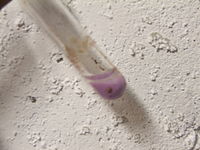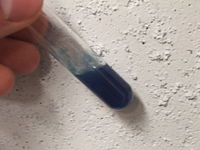- Cobalt(II) hydroxide
-
Cobalt(II) hydroxide Cobalt(II) hydroxideOther namesCobaltous hydroxide, cobalt hydroxide, cobaltous hydrateIdentifiers CAS number 21041-93-0 
PubChem 10129900 ChemSpider 8305419 
Jmol-3D images Image 1 - [Co+2].[OH-].[OH-]
Properties Molecular formula Co(OH)2 Molar mass 92.948 g/mol Appearance rose-red powder or bluish-green powder Density 3.597 g/cm3 Melting point 168 °C (decomp)[1]
Solubility in water 3.20 mg/L Solubility product, Ksp 1.0×10−15 Solubility soluble in acids, ammonia; insoluble in dilute alkalis Structure Coordination
geometryrhombohedral Thermochemistry Std enthalpy of
formation ΔfHo298-539.7 kJ·mol−1 Standard molar
entropy So29879.0 J·mol−1·K−1[2] Hazards MSDS Oxford University EU classification Harmful (H) R-phrases R20 R21 R22 R36 R37 R38 R43 S-phrases S24 S26 S36 S37 S39[3] NFPA 704 Related compounds Other anions Cobalt(II) chloride
Cobalt(II) bromide
Cobalt(II) iodideOther cations Iron(II) hydroxide
Nickel(II) hydroxide
Copper(II) hydroxide hydroxide (verify) (what is:
hydroxide (verify) (what is:  /
/ ?)
?)
Except where noted otherwise, data are given for materials in their standard state (at 25 °C, 100 kPa)Infobox references Cobalt(II) hydroxide or cobaltous hydroxide is the chemical compound composed of cobalt and the hydroxide ion with the formula Co(OH)2. It occurs in two forms, either as a rose-red powder, which is the more stable of the two forms, or as bluish-green powder.[1][4] It has the brucite or cadmium iodide crystal structure.[5]
Uses
It finds use as a drying agent for paints, varnishes and inks, in the preparation of other cobalt compounds, as a catalyst and in the manufacture of battery electrodes[1].
Reactions
Cobalt(II) hydroxide is precipitated when an alkaline hydroxide is added to an aqueous solution of Co2+ ions:
Cobalt(II) hydroxide decomposes to cobalt(II) oxide at 168 °C under vacuum and is oxidized by air to form cobalt(III) hydroxide, Co(OH)3.[1] The thermal decomposition product in air above 300 °C is Co3O4.[6][7][8]
Like iron(II) hydroxide, cobalt(II) hydroxide is primarily a basic hydroxide, although it does form the weakly acidic reddish hexaaquacobalt(II) ion, [Co(H2O)6]2+, in acidic aqueous solutions. In strong bases, cobalt(II) hydroxide accepts additional hydroxide ions to form dark blue cobaltates(II) [Co(OH)4]2- and [Co(OH)6]4-[5].
References
- ^ a b c d Patnaik, Pradyot (2003). Handbook of Inorganic Chemical Compounds. McGraw-Hill Professional. p. 243. ISBN 0070494398. http://books.google.com/?id=Xqj-TTzkvTEC&pg=PA243. Retrieved 2009-03-27.
- ^ Lide, David R. (1998). Handbook of Chemistry and Physics (87 ed.). Boca Raton, FL: CRC Press. p. 513. ISBN 0849305942.
- ^ "Safety (MSDS) data for cobalt (II) hydroxide". Oxford University. http://msds.chem.ox.ac.uk/CO/cobalt_II_hydroxide.html. Retrieved 2009-03-27.
- ^ Lide, David R. (1998). Handbook of Chemistry and Physics (87 ed.). Boca Raton, FL: CRC Press. p. 454. ISBN 0849305942.
- ^ a b Wiberg, Nils; Wiberg, Egon; Holleman, A. F. (2001). Inorganic Chemistry. Academic Press. pp. 1478–1479. ISBN 0123526515. http://books.google.com/?id=LxhQPdMRfVIC&pg=PA1478. Retrieved 2009-03-27.
- ^ R. S. Jayashree and P. Vishnu Kamath (1999). "Electrochemical synthesis of a-cobalt hydroxide". Journal of Materials Chemistry 9: 961–963. doi:10.1039/A807000H.
- ^ Synthesis of Co3O4 during thermolysis of cobalt hydroxide and binary hydroxides, L.A. Paikina, S.M. Rakhovskaya, L.A. Vereshchagina, Neorganicheskie Materialy. Vol. 19, no. 9, pp. 1508–11. 1983
- ^ Z. P. Xu and H. C. Zeng (1998). "Thermal evolution of cobalt hydroxides: a comparative study of their various structural phases". Journal of Materials Chemistry 8 (11): 2499–2506. doi:10.1039/A804767G.
Cobalt compounds Categories:- Cobalt compounds
- Hydroxides
Wikimedia Foundation. 2010.



